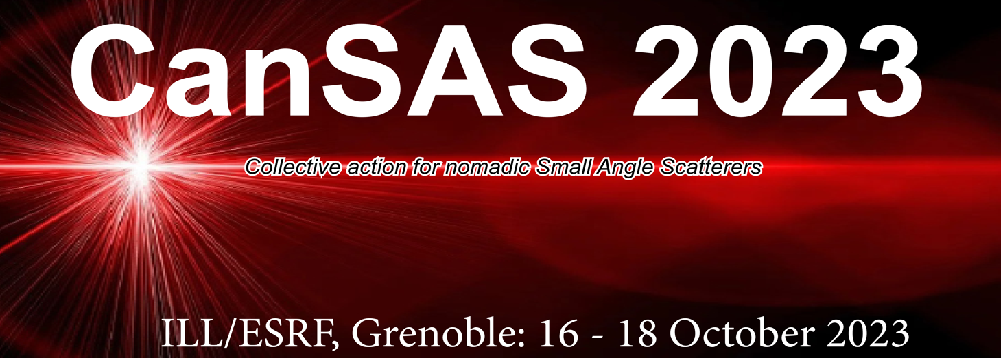At the 2017 canSAS workshop I was first introduced to the concept of applying Machine Learning (ML) algorithms to analysing scientific datasets. Since then I have moved towards adopting an increasing number of ML based techniques for data analysis with a view towards developing truly adaptive experimentation.
Lofty words.
Wondrous ideals.
I would like to share with the community what...
Lyotropic phases, which encompass structures like lamellar or sponge formations, constitute a significant category within the realm of soft matter. The characterization of these lyotropic phases has often relied on the technique of small angle scattering. The impact of curvatures on the diverse lyotropic mesomorphism has been widely acknowledged. However, conventional regression analysis based...
Small-angle X-ray scattering (SAXS) is a powerful characterization technique for nanoscale structures in materials. The analysis of SAXS is a modeling-heavy process to find a plausible structure model that corresponds to the measured scattering intensity due to the inherent “phase problem” of the X-ray detection. Despite various scientific computing tools to assist the model selection, the...
Autonomous experimentation (AE) holds enormous promise for accelerating scientific discovery. This paradigm leverages machine-learning methods to construct experimental loops where the machine selects and conducts experiments, liberating the human scientist to focus on high-level goals and understanding. This talk will discuss autonomous experiments (AE) at synchrotron x-ray scattering...
In our (dramatically understaffed) X-ray scattering laboratory, developing a systematic, holistic methodology1 let us provide scattering and diffraction information for more than 2100 samples for 200+ projects led by 120+ collaborators over the last five years. Combined with universal, automated data correction pipelines, as well as our analysis and simulation software, this led to more than...
For users to make informed decisions about adapting their experimental setup or inspect the decisions of an autonomous experiment, it is essential to extract and visualize relevant features from scattering patterns as they are collected. Making use of browser-based technologies further enables remote, device-independent and installation-free access, as well as providing standards-based...
Systemic lupus erythematosus (SLE) is an autoimmune disease. The immune system attacks its tissues, including Inflammation of the skin, joints, blood, kidneys, and nervous system. The nephrologist determines the drug treatment by referring to clinic symptoms, medical history, pathology reports, blood tests, etc. Serum albumin (SA) and 2-subtype immunoglobulin (IgG and IgA) concentrations have...
The Advanced Photon Source of the Argonne National Laboratory in the United States is currently undergoing a shutdown in order to upgrade its storage ring to a multi-band achromat. The expectation is to recommence operations of the ring in the year 2024. Accordingly, the 12-ID-C beamline, which is a dedicated Small-Angle X-ray Scattering (SAXS) beamline, has been actively developing a setup to...
Lensless X-ray coherent diffraction imaging (CDI), facilitated by ptychography, has emerged as a thriving field with promising applications in materials and biological sciences with a theoretical imaging resolution only limited by the X-ray wavelength. Most small-angle scattering based CDI methods use transmission geometry, which is not suitable for nanostructures grown on opaque substrates or...
The structural connectivity of the brain has been addressed by various imaging techniques such as diffusion weighted magnetic resonance imaging (DWMRI) or specific microscopic approaches based on histological staining or label‑free using polarized light (e.g., three‑dimensional Polarized Light Imaging (3D‑PLI), Optical Coherence Tomography (OCT)). These methods are sensitive to different...
The conformations and compositions of a proton-translocating pyrophosphatase Vigna radiata H+-PPase (VrPPase), stabilized by either detergent molecules or embedded in a lipid nanodisc in aqueous solution, are revealed using size exclusion chromatography coupled small-angle X-ray scattering (SEC-SAXS) with online UV-Vis absorption and refractive index (RI) detections. The integrated analysis of...
GENFIT is a well-established software tool for analysing small-angle scattering (SAS) data from X-ray (SAXS) or neutron (SANS) experiments. It reads a set of one-dimensional scattering curves and fits them using different kinds of models [1-8]. SAS curves calculated from a model can be smeared to allow for the instrumental resolution. The user can fit the experimental data selecting one or...
To increase the information content of small-angle scattering data, it is usual to perform contrast variation small-angle neutron scattering (SANS) with one or more of the components deuterated and by varying the composition of the solvent using mixtures of per-deuterated and non-deuterated solvents. Additional information can be added by combination with small-angle X-ray scattering (SAXS)...
BornAgain [1,2] is an open-source software package to model and fit SAS, GISAS, off-specular scattering, and reflectometry. It was designed to fully reproduce the functionality of the standard software IsGisaxs [3], allow for hierarchical sample models of arbitrary complexity, and support neutron polarization and magnetic scattering. It can be used either through a graphical user interface or...
The Small Angle Scattering Biological Data Bank (SASBDB) at EMBL is an open-access, freely available, and searchable resource for the structural-biological/biophysical and biotechnology communities and is the only curated repository for small angle X-ray (SAXS) and neutron scattering (SANS) data. SASBDB was established in 2014 for the deposition SAS projects focusing on the structure(s) of...

